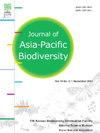文章题目云南南部野蛙群一新种(无尾目,野蛙科)
IF 0.7
Q4 BIODIVERSITY CONSERVATION
引用次数: 0
摘要
云南黄连山国家级自然保护区内一新种。形态学上,新种体长适中(成年雄鼻口长38.3 ~ 40.8 mm,成年雌鼻口长62.3 ~ 63.1 mm),头长大于宽,鼻孔到鼻尖的距离略小于眼到鼻孔的距离,有松果体,鼓室明显,雄鼻不可见,雌鼻弱可见,背外侧褶皱明显,跖外结节无。成年雄性存在声囊和婚垫,头部和身体背表面为绿色,无或少数黑点,后下侧腹有几个大而平的白色结节。遗传上,新种与其他种的16S核糖体RNA遗传距离为3.0% ~ 7.6%,NADH脱氢酶亚基2基因序列遗传距离为7.2% ~ 17.1%。目前,该新种仅在中国云南省红河州吕春县的模式区发现。本文章由计算机程序翻译,如有差异,请以英文原文为准。
A new species of the Amolops monticola group (Anura, Ranidae) from southern Yunnan, China
A new species of the Amolops monticola group is described from Yunnan Huanglianshan National Nature Reserve, southern Yunnan, China. Morphologically, the new species is characterized by a moderate body size (snout–vent length 38.3–40.8 mm in adult males and 62.3–63.1 mm in adult females), head being longer than wide, nostril to snout tip distance being slightly smaller than eye to nostril distance, the presence of pineal body, distinct tympanum, vomerine teeth being invisible in males and weak but visible in females, distinct dorsolateral folds, the absence of outer metatarsal tubercle, the presence of vocal sac and nuptial pad in adult males, dorsal surface of head and body being green with no or a few black dots, and the presence of a few large flat white tubercles on the posterior inferior flank. Genetically, the uncorrected genetic distance between the new species and other species of the A. monticola group ranged from 3.0% to 7.6% in 16S ribosomal RNA and from 7.2% to 17.1% in NADH dehydrogenase subunit 2 gene sequences. Currently, the new species is known only from its type locality in Lvchun County, Honghe Prefecture, Yunnan Province, China.
求助全文
通过发布文献求助,成功后即可免费获取论文全文。
去求助
来源期刊

Journal of Asia-Pacific Biodiversity
Agricultural and Biological Sciences-Insect Science
CiteScore
1.70
自引率
12.50%
发文量
94
审稿时长
27 days
期刊介绍:
The Journal of Asia-Pacific Biodiversity (previous title was Journal of Korean Nature) is an official journal of National Science Museum of Korea (NSMK) and Korea National Arboretum (KNA). The scope of journal is wide and multidisciplinary that publishes original research papers, review articles, as well as conceptual, technical and methodological papers on all aspects of biological diversity-its description, analysis and conservation, and its application by humankind. This wide and multidisciplinary journal aims to provide both scientists and practitioners in conservation theory, policy and management with comprehensive and applicable information. However, papers should not be submitted that deal with microorganisms, except in invited paper. Articles that are focused on the social and economical aspects of biodiversity will be normally not accepted.
 求助内容:
求助内容: 应助结果提醒方式:
应助结果提醒方式:


